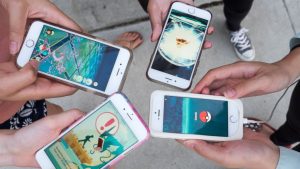Since its launch in July, Pokémon GO has taken the world by storm. The game had over 7.5 million downloads in the first week of release in the US alone and there are now more people playing than there are accounts on Twitter!
The gaming app soared to the top of the Apple and Android app stores in record time, spurring socialisation and promoting exercise as users go out into the real world to catch Pokémon, visit virtual Pokéstops and battle using their smartphone and its GPS capability. The augmented reality experience is inspiring other companies, as Apple’s chief executive Tim Cook confirmed investment in the technology, describing the platform as “huge”. So how can the augmented reality phenomenon create marketing and revenue opportunities for businesses?
Augmented reality meets digital marketing
For those who are unaware of all things Pokémon, users of Pokémon GO can visit landmarks and places of interest, such as parks, restaurants and bars, to interact with friends and progress within their own virtual universe. Local businesses that are featured ‘PokéStops’ can attract players by providing virtual objects that enhance their experience in the game. When you consider the volume of players and the popularity of the game, this is a valuable tool for increasing Pokémon GO foot traffic. This could very easily be turned into real-life revenue, as players buy food at their local PokéStop, a cup of coffee at a Pokémon GO gym, or pay for virtual objects in the app.
As the popularity of augmented reality grows, so will the commercial opportunities for businesses and marketers. Nintendo has announced it will be offering local businesses the opportunity to pay to become sponsored Pokémon Gyms and PokéStops. This is already happening in Japan, where around 3,000 McDonald’s restaurants are now sponsored to attract paying (and playing) customers. Companies could also create virtual billboards, branded characters and missions. So much potential is being carried around in our smartphones, and it’s down to marketers to expose those opportunities. While the potential for B2C marketers is obvious, what can B2B marketers learn from the digital success AR gaming has achieved?
From gamers to decision makers
According to SurveyMonkey Intelligence, Pokémon GO isn’t just a game for children, with 46% of players aged between 18 and 29. With an estimated population of 83.1 million, the millennial generation (those born between 1980 and 2000) is a powerful consumer force. However, many aren’t swayed by traditional advertising, so how marketers are now looking to new tactics to reach millennials.
This generation tends to spend more time on mobile phones than previous generations as it is easier for them to adapt to emerging technology. Millennials want readily accessible, real-time data that will help them make the most out of their time. These findings reinforce the shift toward mobile-friendly content, whether that is through social media, blogging, digital advertising or gaming apps, like Pokémon GO.
The next generation of digital advertising is expected to be done on a platform of augmented and virtual reality, and mobile phones continue to change the way businesses do their marketing; allowing one-to-one interaction between businesses and consumers. Pokémon GO is leading the way for future digital marketing, and B2B marketers are expected to follow suit.
Augmented reality in the lab
While augmented reality is great for games and marketers, methods are also being developed to incorporate AR into laboratory and research settings. Smart glasses, geared towards manufacturing professionals, have been developed with augmented reality software. These can be used to perform troubleshooting from remote locations, allow quick inspections, train employees and cut down on travel costs. Hand gestures and voice commands can also be used to pull up important documents stored in one location. This app could prevent expensive errors from occurring as people wearing the glasses can take pictures or capture videos of malfunctioning equipment or dangerous conditions.
AR is also expected to be used in medical education. Since training in real-life scenarios is not always possible due to safety and cost implications, educational technology has the potential to offer students a highly realistic situated learning experience, supportive of complex medical learning.
AR gives B2B marketers the opportunity to create more relevant, impactful content that can be taken to market in new, innovative ways. While it may seem childish excitedly engaging with Nintendo’s new gaming app, imagine your audience having the same reaction to your marketing content. Furthermore, as AR enters the world of science and technology, young researchers will be exposed to endless digital opportunity, and they will be expecting a similar level of engagement from marketers.
If you want an agency that is open to innovative PR approaches, give us a call on +44 (0) 1477 539 539 or email [email protected].
By Madison Dunn, Account Executive at The Scott Partnership.





